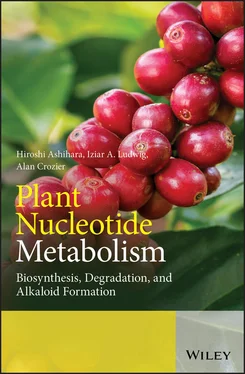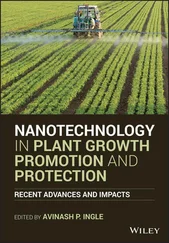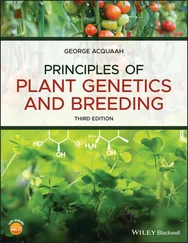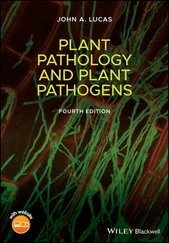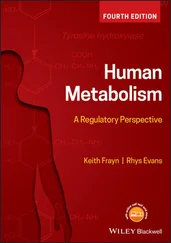1 ...6 7 8 10 11 12 ...24 a)Two week Pi starvation.
2.2 Pyridine Nucleotides
2.2.1 Concentration of Pyridine Nucleotides
Pyridine nucleotides, NAD and NADP occur in oxidized (NAD +and NADP +) and reduced forms (NADH and NADPH). While HPLC techniques exist for separating and quantifying NAD and NADP, both can be readily quantified through well-established and sensitive enzymatic cycling assays. It is a simple matter to distinguish between NAD and NADP either through the use of specific enzymes or by HPLC. More problematical is discrimination between the reduced and oxidized forms. Usually, this is achieved by exploiting the different stability of the two forms in acid and alkaline extraction buffers. High-throughput methods have been developed that can measure the two nucleotides at the same time as other redox compounds (Queval and Noctor 2007).
Concentrations of NAD +, NADH, NADP +and NADPH reported in young A. thaliana are shown in Table 2.3. The NADH/NAD +and NADPH/NADP +ratios vary according to the physiological conditions. However, the concentration of the oxidized form (NAD +) in plants is higher than that of the reduced form (NADH) (Wang and Pichersky (2007).
Table 2.3 Concentrations of NAD +, NADH, NADP +, and NADH in Arabidopsis thaliana (ecotype Col-0, wild-type) plants.
Source: In part based on data of Wang and Pichersky (2007).
| Tissue |
NAD + |
NADH |
NAD +/NADH |
NADP + |
NADPH |
NADP +/NADPH |
| Root |
6.5 |
0.2 |
(31.4) |
1.7 |
0.3 |
(5.7) |
| Roselle leaves |
10.2 |
4.5 |
(2.8) |
2.8 |
— |
— |
| Stem |
12.0 |
— |
— |
3.1 |
— |
— |
| Cauline leaves |
11.3 |
4.0 |
(3.4) |
3.6 |
— |
— |
| Flower |
27.0 |
3.6 |
(9.1) |
4.5 |
1.0 |
(4.0) |
| Silique |
17.9 |
2.8 |
(4.5) |
3.8 |
0.6 |
(6.4) |
| Seedlings |
9.9 |
0.9 |
(11.9) |
2.0 |
0.4 |
(6.0) |
The values (nmol g −1f.w.) and the NAD(P) +/NAD(P)H ratios are obtained from different tissues.
A full understanding of pyridine nucleotide-related biological phenomena requires techniques that determine specific pool sizes in different intracellular compartments. The fluorescent properties of reduced pyridine nucleotides have been exploited in the analysis of plant mitochondrial metabolism (Kasimova et al. 2006). However, these measurements do not distinguish between the NADH and NADPH signals. The limitations of the information generated by the different methods of measuring pyridine nucleotides have been discussed by Hagedorn et al. (2004).
2.2.2 Concentration of Nicotinate and Nicotinamide
In contrast to pyridine nucleotides, the pool sizes of nicotinate ( 5) and nicotinamide ( 6) are very small. These metabolites, produced by pyridine nucleotide degradation, are converted rapidly to trigonelline ( 7, N -methylnicotinate) or nicotinate glucosides (Ashihara et al. 2015). Typically, when the concentration of niacin, which comprises nicotinamide, nicotinate, and vitamin B 3, is analysed in foodstuffs, the contribution of these individual components is not considered. Common extraction treatments, such as alkaline or acid hydrolysis, mean that any NAD, NADP, nicotinamide, and other nicotinate-related metabolites present in the sample are converted to nicotinate, which is the form that is then measured as niacin (Noctor et al. 2011).
2.3 Concentration of Cytokinins
Cytokinins are a class of phytohormones (aka growth substances) that promote cell division in plants. They are involved primarily in cell growth and differentiation, but also affect apical dominance, axillary bud growth, and leaf senescence. Cytokinins, such as isopentenyladenine ( 8), trans -zeatin ( 9), and benzyladenine ( 10) are adenine-derived plant hormones. The major sites of cytokinin biosynthesis are roots, cambium, and other actively dividing tissues. Cytokinins play vital roles in the regulation of multiple physiological processes in plants including cell proliferation and differentiation, nutrient allocation, leaf senescence, and responses to external biotic and abiotic signals (Bishop et al. 2015; Crozier et al. 2000).
Compared to purine nucleotides, the concentration of cytokinins is extremely low. Cytokinins are now routinely analysed using ultra-performance HPLC–high resolution mass spectrometry. The concentration of isopentenyladenine cytokinins, isopentenyladenine ( 8), isopentenyladenine ribotide ( 11), and isopentenyladenine riboside ( 12) in A. thaliana seedlings has been reported to be 0.4, 2.4, and 5.7 pmol g −1f.w., respectively. While those of trans -zeatin cytokinins, trans -zeatin ( 9), trans -zeatin riboside ( 13) and trans -zeatin ribotide ( 14) were 0.6, 2.8, and 1.6 pmol g −1f.w., respectively. Levels of dihydrozeatin ( 15) and benzyladenine cytokinins were <20 fmol g −1f.w. (Novák et al. 2008).
2.4 Alkaloids Derived from Nucleotides
Some alkaloids, derived from purine and pyridine nucleotides, accumulate in specific plant species. Caffeine and nicotine ( 16) are typical nucleotide-derived alkaloids. For example, high concentrations of caffeine (∼2% d.w.) are found in tea ( Ca. sinensis ) and coffee ( C. arabica ) (Ashihara et al. 2017), while nicotine (∼1% d.w.) accumulates in tobacco ( N. tabacum ) (Saitoh et al. 1985). These alkaloids occur in more than 100 plant species. Detailed distribution and concentration of these alkaloids are described in purine and pyridine alkaloids in Parts Vand VI.
Occurrence of major purine, pyrimidine, and pyridine nucleotides in plants are summarized. For comparison, cytokinins and nucleotide alkaloids are also noted. In most plants, the concentration of nucleotides is higher than nucleosides and bases. Cytokinins occur in much lower amounts than purine nucleotides. A much higher concentration of caffeine is found in tea and coffee plants.
1 Ashihara, H. and Crozier, A. (1999). Biosynthesis and catabolism of caffeine in low-caffeine-containing species of Coffea. J. Agric. Food. Chem. 47: 3425–3431.
2 Ashihara, H., Yabuki, N., and Mitsui, K. (1990). A high-performance liquid chromatography method for separation of purine bases, nucleosides and ureides: application to studies on purine catabolism in higher plants. J. Biochem. Biophys. Methods 21: 59–63.
3 Ashihara, H., Ludwig, I., Katahira, R. et al. (2015). Trigonelline and related nicotinic acid metabolites: occurrence, biosynthesis, taxonomic considerations, and their roles in planta and in human health. Phytochem. Rev. 14: 765–798.
4 Ashihara, H., Mizuno, K., Yokota, T., and Crozier, A. (2017). Xanthine alkaloids: occurrence, biosynthesis, and function in plants. In: Progress in the Chemistry of Organic Natural Products, vol. 105 (eds. A.D. Kinghorn, H. Falk, S. Gibbons and J. Kobayashi), 1–88. Cham: Springer International Publishing.
5 Ashihara, H., Stasolla, C., Fujimura, T., and Crozier, A. (2018). Purine salvage in plants. Phytochemistry 147: 89–124.
6 Atkinson, D.E. (1977). Cellular Energy Metabolism and its Regulation. New York: Academic Press.
Читать дальше
